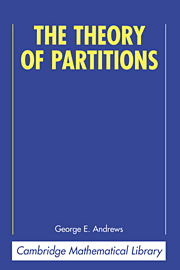Book contents
- Frontmatter
- Editor's Statement
- Contents
- Preface to Paperback Edition
- Preface
- Chapter 1 The Elementary Theory of Partitions
- Chapter 2 Infinite Series Generating Functions
- Chapter 3 Restricted Partitions and Permutations
- Chapter 4 Compositions and Simon Newcomb's Problem
- Chapter 5 The Hardy–Ramanujan–Rademacher Expansion of p(n)
- Chapter 6 The Asymptotics of Infinite Product Generating Functions
- Chapter 7 Identities of the Rogers–Ramanujan Type
- Chapter 8 A General Theory of Partition Identities
- Chapter 9 Sieve Methods Related to Partitions
- Chapter 10 Congruence Properties of Partition Functions
- Chapter 11 Higher–Dimensional Partitions
- Chapter 12 Vector or Multipartite Partitions
- Chapter 13 Partitions in Combinatorics
- Chapter 14 Computations for Partitions
- Index for Definitions of Symbols
- Author Index
- Subject Index
Chapter 8 - A General Theory of Partition Identities
Published online by Cambridge University Press: 10 February 2010
- Frontmatter
- Editor's Statement
- Contents
- Preface to Paperback Edition
- Preface
- Chapter 1 The Elementary Theory of Partitions
- Chapter 2 Infinite Series Generating Functions
- Chapter 3 Restricted Partitions and Permutations
- Chapter 4 Compositions and Simon Newcomb's Problem
- Chapter 5 The Hardy–Ramanujan–Rademacher Expansion of p(n)
- Chapter 6 The Asymptotics of Infinite Product Generating Functions
- Chapter 7 Identities of the Rogers–Ramanujan Type
- Chapter 8 A General Theory of Partition Identities
- Chapter 9 Sieve Methods Related to Partitions
- Chapter 10 Congruence Properties of Partition Functions
- Chapter 11 Higher–Dimensional Partitions
- Chapter 12 Vector or Multipartite Partitions
- Chapter 13 Partitions in Combinatorics
- Chapter 14 Computations for Partitions
- Index for Definitions of Symbols
- Author Index
- Subject Index
Summary
Introduction
The results in Chapter 7 indicate that a general study of partition identities such as the Rogers–Ramanujan identities or the Göllnitz–Gordon identities should help to illuminate these appealing but seemingly unmotivated theorems. In this chapter we shall undertake the foundations of this study. As will become abundantly clear, there are very few truly satisfactory answers to the questions that we shall examine. We shall instead have to settle for partial answers. After presenting the fundamental structure of such problems in the next section, we devote Section 8.3 to “partition ideals of order 1,” a topic which we can handle adequately and which suggests the type of answers we would like for our general questions of Section 8.2. The final section of the chapter describes a large class of partition problems wherein the related generating function satisfies a linear homogeneous q-difference equation with polynomial coefficients. In some ways this final section is unsatisfactory, in that the theory of q-difference equations has not been adequately developed to provide answers generally to questions about partition identities and partition asymptotics; however, the theorems of Section 8.4 do suggest that q-difference equations are indeed worthy of future research.
Foundations
We begin with a simple intuitive observation which forms the basis of our work here. In all the partition identities considered in Chapter 7 (Theorem 7.5, Corollaries 7.6 and 7.7, Theorem 7.11) partition functions were considered that enumerated partitions lying in some subset C of the set of all partitions.
- Type
- Chapter
- Information
- The Theory of Partitions , pp. 121 - 138Publisher: Cambridge University PressPrint publication year: 1984

